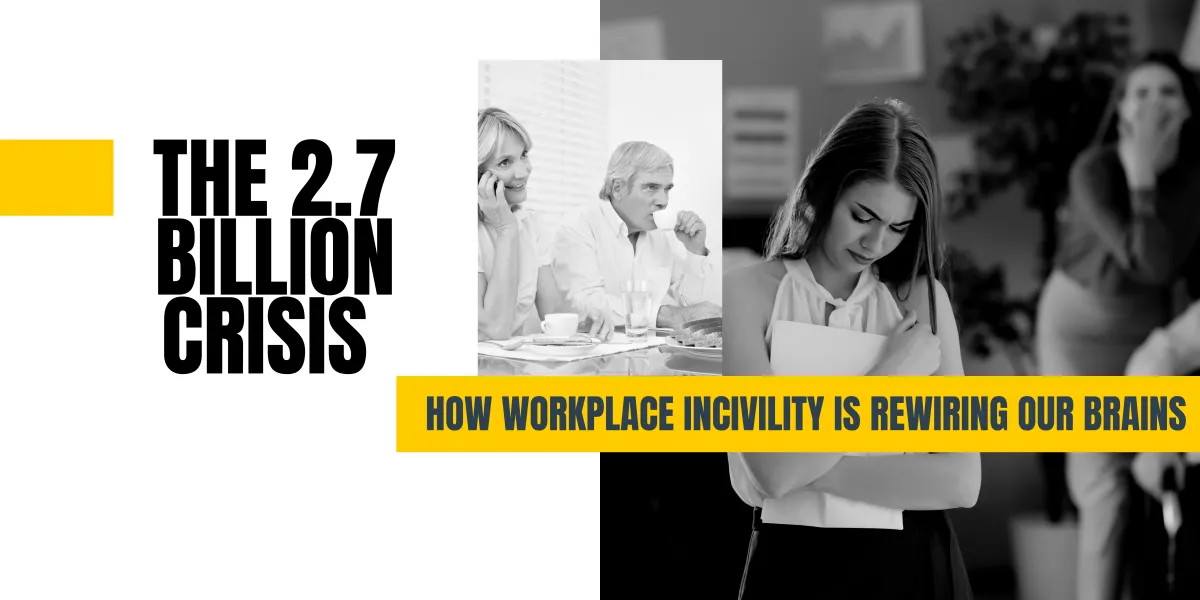
The $2.7 Billion Crisis
The numbers are staggering. U.S. organizations are losing over $2.7 billion per day due to workplace incivility—and it's only getting worse. According to SHRM's Q4 2024 Civility Index, workplace incivility has reached record highs, with 74% of workers expecting these toxic behaviors to remain the same or worsen in 2025.

But here's what most leaders don't realize: incivility isn't just a behavioral problem—it's a neurological crisis that's literally rewiring our brains and crippling our organizations from the inside out.
The Hidden Face of Workplace Incivility
Workplace incivility often flies under the radar because it's not always obvious. While we might think of dramatic confrontations or overt harassment, research defines workplace incivility as "low-intensity deviant workplace behaviors with an ambiguous intent to harm."
Common forms of workplace incivility include:
Interrupting colleagues during meetings or conversations
"Forgetting" to share credit for collaborative work
Intentionally ignoring team members or excluding them from discussions
Making disparaging comments about colleagues' ideas or backgrounds
Public criticism or shaming disguised as "feedback"
Passive-aggressive behaviors like delayed responses or withholding information
Microaggressions based on identity, background, or beliefs
Your Brain on Incivility: The Neuroscience Behind the Crisis
Here's what happens in your brain when you experience workplace incivility:
The Threat Response Cascade. When employees encounter uncivil behavior, their brains respond as if facing a physical threat. The amygdala and limbic system immediately activate, flooding the body with stress hormones. Cognitive resources are instantly diverted away from the prefrontal cortex—the brain region responsible for executive functions like decision-making, collaboration, and creative thinking.
The 37-Minute Recovery. The SHRM research shows that workers lose an average of 37 minutes of productivity per act of incivility. Neuroscience explains why: it takes significant time for the brain's threat-response system to calm down and for cognitive function to fully return. During this recovery period, employees struggle with impaired memory, reduced focus, and compromised problem-solving abilities.
The Contagion Effect. Perhaps most alarming, research shows that even witnessing incivility toward others impairs cognitive function. This means that one uncivil act doesn't just affect the target—it creates ripple effects throughout entire teams and departments.
Long-term Brain Changes Chronic exposure to workplace incivility can lead to structural brain changes, increasing the risk of depression and anxiety while creating lasting impacts on mental health and performance.
Three Neuroscience-Backed Strategies for Leaders
The good news? There is three researched backed brain-based interventions that can break the cycle of incivility:
1. Implement the "Notice and Name" Protocol
Train your teams to recognize their own threat responses using a three-level system:
Level 1: Mild alertness (productive stress)
Level 2: Distraction and alarm (beginning to lose focus)
Level 3: Irritation and reactivity (impaired judgment)
When employees can identify their threat level in real-time, it engages the prefrontal cortex and dampens the limbic system's response. This simple awareness practice can prevent minor tensions from escalating into major conflicts.
2. Teach Emotional Labeling Techniques
Research shows that putting emotions into words—a technique called "labeling"—activates the brain's natural braking system. When employees learn to internally describe their emotional state ("I'm feeling frustrated because my status feels threatened"), it:
Reduces limbic system activation
Re-engages executive brain functions
Prevents automatic reactive responses
This is not emotional suppression (which research shows makes things worse), but rather conscious emotional recognition.
3. Apply the SCARF Framework for Civil Communication
Train leaders and employees to understand how incivility threatens five key domains:
Status: Sense of importance relative to others
Certainty: Ability to predict what happens next
Autonomy: Feeling of control over one's environment
Relatedness: Connection with others
Fairness: Perception of equitable treatment
When communicating, especially in tense situations, focus on:
Maintaining neutral to positive tone
Providing clarity without cognitive overload
Acknowledging others' perspectives while redirecting to productive outcomes
Avoiding "hidden messages" that might trigger threat responses
The Business Case for Action
With workers planning to leave their jobs due to incivility, and the average cost per new hire at $4,683, the financial imperative is clear. But beyond the numbers, there's a human imperative: 76% of workers experienced or witnessed incivility in Q4 2024 alone.
The organizations that will thrive in 2025 and beyond are those that recognize incivility as the neurological crisis it truly is—and respond with science-backed solutions rather than hoping the problem will solve itself.
The choice is yours: Will you invest in creating psychologically safe environments that allow brains to do their best work? Or will you continue losing $2.7 billion per day to a problem that neuroscience has already shown us how to solve?
